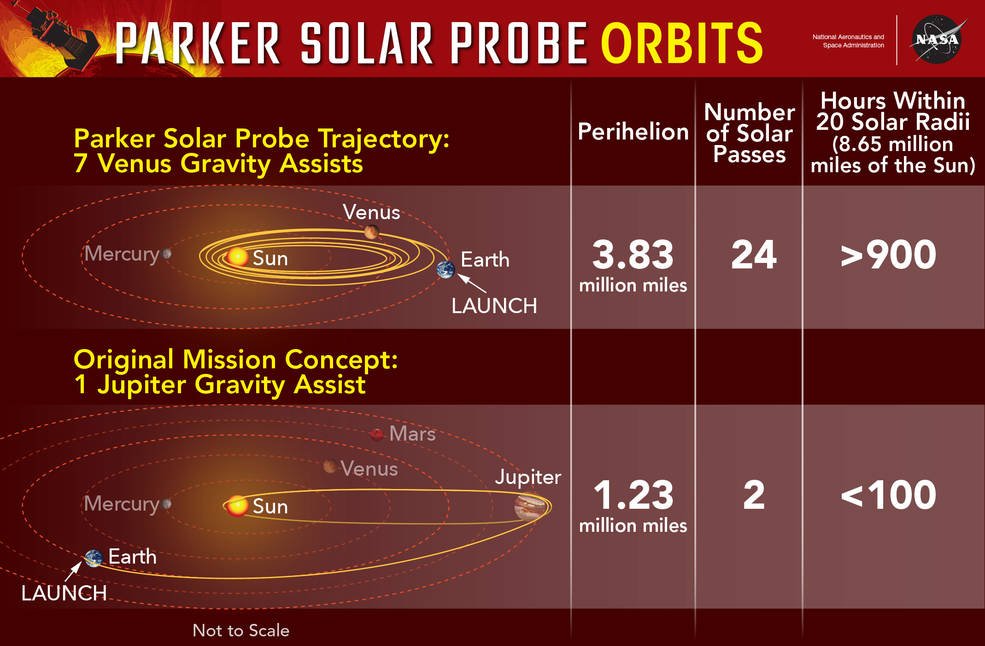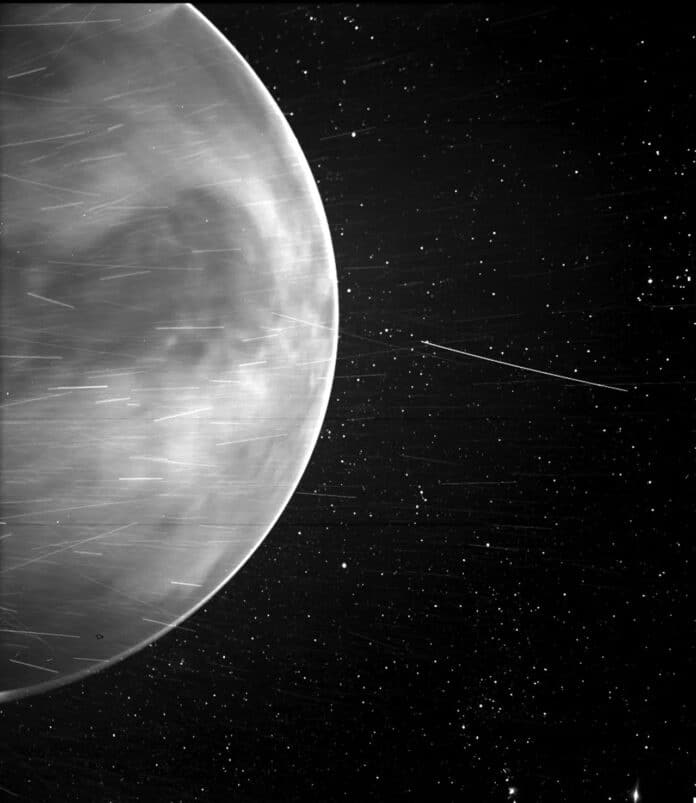On Oct. 3, 2018, Parker Solar Probe performed the first significant celestial maneuver of its seven-year mission. As the orbits of the shuttle and Venus combined toward a similar point, Parker Solar Probe slipped in front of the planet, permitting Venus’ gravity — moderately little by celestial standards — to twist its way and change its speed.
This move, called a gravity assist, decreased Parker’s speed in respect to the Sun by 10 percent — adding up to 7,000 miles for each hour — drawing the nearest purpose of its orbit, called perihelion, closer to the star by 4 million miles.
Performed six more times through the span of the seven-year mission, this gravity helps will in the end convey Parker Solar Probe’s nearest way to deal with a record 3.83 million miles from the Sun’s surface — about a seventh the distance of the current record-holder, Helios 2, which accomplished a go of 27 million miles from the Sun in 1976.
Indeed, even before its nearest approach, Parker Solar Probe is relied upon to overwhelm this record and turn into the nearest human-made protest the Sun in late October 2018.
Yanping Guo, mission design and navigation manager for the Parker Solar Probe mission at the Johns Hopkins University Applied Physics Lab in Laurel, Maryland said, “No one believed using Venus gravity assists would be possible, because the gravity assist a planetary body can provide is proportional to the body’s mass, and Venus’ mass is so much smaller — only 0.3 percent of Jupiter’s. You compare the gravity assist Venus can provide to what Jupiter can provide, and you have to do repeated flybys to achieve the same change. Then you’re getting a very long mission duration.”
Touching the sun is not that much easy. Any shuttle propelled from Earth begins off going at our planet’s 67,000-mile-per-hour sideways pace, a speed that it must neutralize before it can go anyplace close to the Sun. Gravity assists are a standout amongst the most ground-breaking tools in an orbit designer’s toolbox to solve this problem: Instead of utilizing costly, valuable fuel to alter course or speed (or both), gravity assists let you tackle the natural pull of a planet, with time as the main expense.
Credits: NASA/JHUAPL
The idea for a solar probe gravity assist was a little different. In the original orbit plans, the primary functions of the Jupiter gravity assist were to slow the spacecraft’s speed to almost nothing and fling it upwards, out of the nearly-flat plane that contains all of the known planets of the solar system, called the ecliptic plane.
This would put the solar probe on a path to get a rare and better-than-ever look at the Sun’s polar regions, which are difficult to image, but important scientifically as they produce some of the Sun’s high-speed solar wind. Nearly all of our solar observatories have orbited in the ecliptic plane, with the exception of Ulysses, which used a Jupiter gravity assist to achieve polar passes more than 200 million miles from the Sun.
But sending a spacecraft out to Jupiter and bringing it back into the inner solar system is hard. First, no matter how you plan the journey, it’s a long mission, with a minimum of nearly half a decade between meaningful events. Most of the time would be spent cruising in deep space.
Second, traveling that far from the Sun means you have to get creative with power. Near Jupiter, the sunlight is about 25 times dimmer than what we experience at Earth, so the only options are huge solar panels to make the most of the sparse sunlight, or some other source of power, like nuclear.
Large solar panels pose a problem for a solar probe, though, because the panels would need to be shielded during solar encounters to avoid overheating. The size of a solar panel required to power the spacecraft out near Jupiter is too big to effectively stow near the Sun, so they’d have to be jettisoned at perihelion — and that limits you to just one solar pass, once you’ve lost your source of power.
With nuclear power — a radioisotope thermoelectric generator, or RTG, the same source that powers deep-space missions like Cassini and New Horizons — performing a Jupiter gravity assist is a viable option.
Changing the mission paradigm
But the mission design was soon to change. David McComas, chair of the definition committee, remembers a call from Andy Dantzler, then project manager for the Solar Probe mission at APL. Dantzler passed away in 2011 at age 49; the Delta IV Heavy rocket that carried Parker Solar Probe to space was dedicated to him.
McComas said, “Andy asked if there was any way the committee might go for a mission where you stay in the ecliptic plane but have lots of passes by the Sun and slowly reduce the perihelion.”
This was a totally new worldview for the mission. A sign of the first plan was disregarding the Sun’s posts, the wellspring of the Sun’s fast solar wind yet a district of relative mystery to researchers. Furthermore, remaining in the ecliptic plane would more likely than not mean winding up more remote from the Sun than had already been foreseen.
Subsequently, two developments supported the choice to make these changes to the orbit and create the Parker Solar Probe mission we know today.
The first was new research published in 2009 by Thomas Zurbuchen — then a scientist at the University of Michigan and now the associate administrator for the Science Mission Directorate at NASA Headquarters in Washington. This research showed that the solar wind that could be measured from the ecliptic plane was actually from a diverse mix of sources. It was not only the slower solar wind known to be more common near the Sun’s equator but also the high-speed solar wind that often originates closer to the Sun’s poles. By sampling the solar wind from the ecliptic plane over a period of years, scientists could learn about this fast solar wind in ways they hadn’t previously anticipated.

Credits: NASA’s Goddard Space Flight Center/Mary Pat Hrybyk-Keith
The second development was the shift that made such sampling possible: the design of Parker Solar Probe’s current trajectory.
Venus is in constant movement around the Sun, so every time the shuttle passes the planet and swings around our star, Venus is in a totally better place. Yet, Guo’s design solves the problem, with various open doors for launch. This direction configuration helps the shuttle through 24 orbits around the Sun.
The seven Venus gravity assists happen at various focuses in the spacecraft orbit, to represent the staging issue — a few, similar to the one on Oct. 3, occur as the rocket heads towards the Sun, while the others occur as Parker Solar Probe hurries from the Sun.
This circle is unequivocally not quite the same as the original single-Jupiter-gravity-assist concept. As opposed to two disregards the Sun’s poles, coming surprisingly close to the surface, this variant of the mission gives 24 goes around the Sun close to its equator, coming surprisingly close to the Sun’s surface.
Despite the fact that Parker Solar Probe doesn’t get as near the Sun, this rendition of the direction gives the shuttle over 900 hours in this basic inward locale of the Sun’s crown, inside 20 solar radii (around 8.65 million miles). In the examination, prior plans utilizing Jupiter gravity helps gave under 100 hours in this region.
This change to the mission also solved the power problem. Instead of requiring an RTG or unmanageably-large solar panels, Parker Solar Probe is powered by a pair of articulated solar panels that are slowly drawn into the shadow of the heat shield as the spacecraft approaches the Sun. At closest approach, only a small area remains exposed to generate the needed power for the spacecraft, cooled by the mission’s first-of-its-kind solar array cooling system.
But though it solved a major problem, rethinking the mission in this way also required a complete rethinking of the spacecraft itself.
Nicola Fox, formerly the mission’s project scientist at APL said, “The whole spacecraft design changed dramatically. With the earlier trajectory, the heat shield was the spacecraft. It was like a cone, with the pointed end facing the Sun, because when you’re doing such a fast polar orbit it’s tough to keep a shield oriented correctly.”
“We aren’t going in as far with the new trajectory, so we could go to a simpler shape for the heat shield because it’s possible to keep the heat shield oriented between the spacecraft and the Sun at all times. The whole thing looks really different.”
During the Oct. 3 gravity assist, Parker Solar Probe came within about 1,500 miles of Venus’ surface, reaching this closest point at about 4:45 a.m. EDT.
Venus is an interesting case for heliophysicists, who study not only the Sun but also its effects on planets. Unlike Earth, Venus doesn’t have an internal magnetic field — instead, a weak magnetic field is induced over the surface by the constant barrage of solar charged particles flowing over the planet and interacting with its very dense atmosphere.
This first flyby offered a unique opportunity for calibration, as Parker Solar Probe flew through the trailing end of Venus’ magnetic field, called the magnetotail. Three of Parker Solar Probe’s four instrument suites — SWEAP, ISʘIS, and FIELDS — gathered data during the flyby on particles and fields in this region.
Though the data is still making its way back to Earth, the science team hopes to analyze it before they set their sights on Parker Solar Probe’s next major celestial encounter: its first close approach to the Sun. Parker Solar Probe’s first solar encounter will happen Oct. 31 – Nov. 11, with the closest approach happening on Nov. 5 at a distance of 15 million miles from the Sun. The science data from this encounter will start downlinking to Earth in early December.
